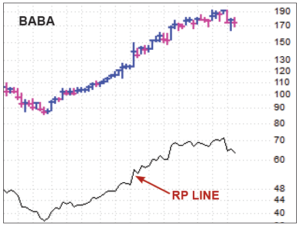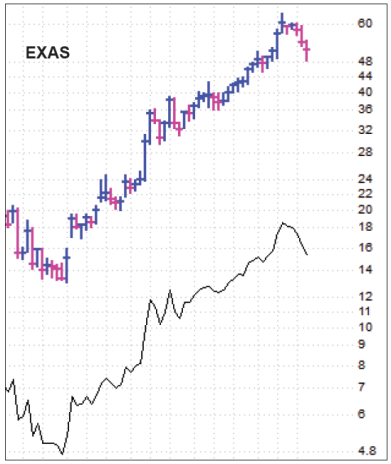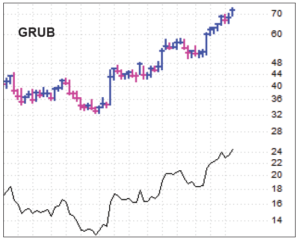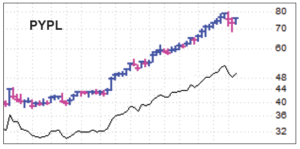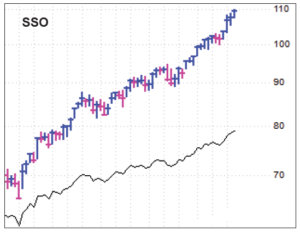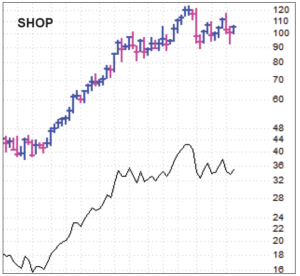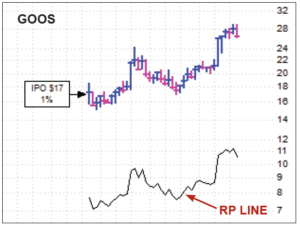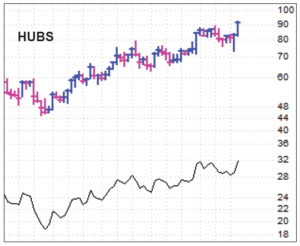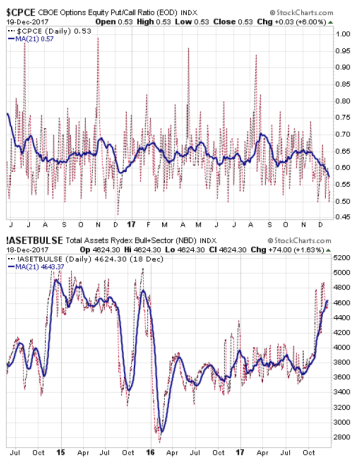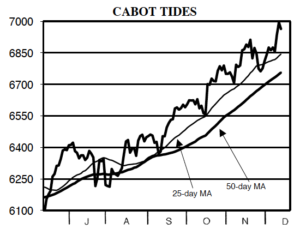As 2017 comes to a close, we all have a lot to be thankful for, as the bull market provided us with a great environment for stock picking. There’s always room for improvement (which we’ll probably write about in future issues), but coming into this week the Model Portfolio was sitting on a gain north of 40%. We’ll take it.
Looking ahead, we remain bullish, especially longer-term, as some big-picture indicators point toward higher prices. Near-term, though, it’s hard to ignore the optimistic sentiment, which we write about in today’s issue. It’s very inexact, so we don’t base trading decisions on it, but it’s good to remember to keep your eyes (and your options) open.
Cabot Growth Investor 1383
[premium_html_toc post_id="142570"]
Our Positive Stance, and System, Produced a Great Year
As we head into the home stretch of 2017, we want to share a heartfelt thank you, first to you for allowing us to do a job we love—unearthing potential big winning stocks and timing the market. And second, for the bull market itself, which has helped us all make good money!
The past couple of years were very tricky and trendless, especially for growth stocks. But as the bulls took control this year, our system took advantage of it—despite some recent wobbles in growth stocks, our Model Portfolio is up more than 40% this year, roughly doubling the return of the S&P 500. In fact, depending on how the year finishes up, it could be the portfolio’s best year since I took over the portfolio 11 years ago (+37% was our prior best return).
That said, while it’s fun to look back after a good year, our focus remains on the present and future. From a big-picture point of view, our trend-following indicators are still bullish, and there are also some positive studies cropping up again based on the market’s recent strength.
One is our own 7.5% Rule, which could produce another Buy signal later ths week. While it’s not likely to be as meaningful as the one we received in March (that was a near-perfect setup), it certainly would be a good sign that the overall bull market is likely to continue in 2018.
There’s also an intriguing study by Ryan Detrick of LPL Financial. Right now, the S&P 500 is historically “overbought” by one technical measure, which has only occurred eight other times since 1950. From these points, the S&P actually rose an average of 5.7%, 10.8% and 13.8% over the next three, six and 12 months, suggesting higher prices are coming down the road.
Thus, longer-term, the bull market should keep running. Shorter-term, though, it’s hard to ignore some of the giddiness we’re seeing—greed is taking hold, most of the economic news is good, and there are many signs of frothiness, which raises the risk of a pullback.
Even so, we never trade based on sentiment because it’s not a great timing tool. But it’s important to keep your feet on the ground and follow the system—do the same things, in other words, that helped us all achieve such solid results this year.
[highlight_box]WHAT TO DO NOW: Today, the system tells us to remain bullish, and on the buy side, look for fresher leading stocks. In the Model Portfolio, we added E*Trade (ETFC) last week, leaving us with 18% in cash. We’re also placing Universal Display back on Buy.[/highlight_box]
Model Portfolio Update
The major indexes have been hopping in recent days as excitement over the tax cut bill (and general end-of-year enthusiasm) has kept buyers active. But growth stocks remain something of a mixed bag, with most of the leaders of this year still correcting, while fresher growth stocks are acting well.
Thus, when looking at new buying, we’re emphasizing stocks that began their uptrends within the past couple of months. Our Watch List is full of these types of stocks, and with the right set up, we’ll be looking to add one or two new names.
Meanwhile, we’re following our plan and honoring our stops with the few portfolio stocks that are consolidating. Most likely, not all will hold up, but some will, and we’ll aim to ride those as their longer-term uptrends reassert themselves.
Current Recommendations
HOLD—Alibaba (BABA 173)—BABA continues to trade sloppily, which isn’t unexpected; the stock is about four weeks into a new launching pad and likely needs more time to come out of the public’s eye. There were reports that retail sales in China were soft in November despite the big November 11 shopping day, which probably added to the recent selling pressure. Even so, we don’t see any major fundamental issues (the firm’s video arm just inked a content deal with Sony and NBC Universal); indeed, analysts have actually nudged up their earnings estimates, and are now expecting growth of 30% in the coming fiscal year (which starts in April). All told, our view of BABA hasn’t changed: We still think it’s one of the top liquid leading growth stocks of the bull market, and given that it broke out from a 30-month post-IPO base in May, it’s highly likely that the stock’s major uptrend has further to run—possibly a lot further as the company’s growth story progresses. But in the near-term, we’ll stay on Hold as the stock gyrates in a sideways range.
BUY—E*Trade Financial (ETFC 50)—We added ETFC to the Model Portfolio last week because we think this Bull Market stock can make a solid move in the weeks and months ahead. Business has been picking up steam in recent quarters (sales growth has been gradually accelerating, coming in at 22% in Q3) as the market has headed higher, and that’s continuing—in November, trading activity rose 19% from a year ago, while customer assets were up 24% and margin balances rose 27%. Moreover, the slow march higher in interest rates should continue to boost interest income (which is E*Trade’s biggest source of revenue). And the corporate tax cut should immediately boost the bottom line by a meaningful amount (the firm has paid a 36.6% total tax rate thus far this year) next year. Stock-wise, ETFC has been volatile in recent days, and a pullback of a couple of points is certainly possible. But the powerful breakout from its tight base in late November looks like the real deal. You can buy some around here if you’re not yet in.
HOLD—Exact Sciences (EXAS 54)—After a very sharp 20% retreat earlier this month, EXAS has bounced decently, though it’s not out completely of the woods; we are keeping our remaining shares (we sold one-third of our stake a couple of weeks ago) rated Hold with a mental stop near the recent low (48 to 49 area). Like most growth stocks that had big runs this year, the odds favor this consolidation being a normal shakeout that gives way to higher prices, and any new data points or projections on Cologuard sales could bring the buyers back. That said, we’ll just follow the plan—if EXAS holds up, we’ll hold onto our shares, but if not, we’ll sell and look for greener pastures.
HOLD—Facebook (FB 178)—FB is an “on the one hand, on the other hand” situation right now. On the positive side of the ledger is the fact that FB remains just a couple percent off all-time highs and that its snapback from the post-Thanksgiving selloff was better than most growth stocks. On the negative side is the fact that the stock’s relative performance (RP) line hasn’t done anything since July (see chart). Given the stock’s more mature status at this point, we’re putting more weight on the bullish factors, especially with the monetization potential of the firm’s core platform (it’s introducing brief video ads ahead of video content to boost revenues, similar to YouTube) and other services (Messenger monetization could be a big story of 2018). Let’s also not forget that the stock is up more than 50% this year! Long story short, we’re sitting tight with this long-term winner, but need to see a meaningful pickup in the RP line to return to a Buy rating.
BUY—Five Below (FIVE 66)—FIVE has enjoyed a great advance during the past few weeks, and we’re pleased to see it decisively lift above the top of its multi-year base, which raises the chances a new, long-term uptrend is underway. Of course, a lot will depend on how the current quarter goes—last year, nearly 39% of the firm’s annual revenues (and 69% of its earnings!) came in the holiday quarter. There’s always risk, but we see no reason to believe that management, which has guided Five Below to years of great growth, will falter now. Back to the stock’s action, the recent advance has pulled it far away from its moving averages (the 25-day line is down at 63), so a retreat here wouldn’t be uncalled for. Hold on if you own some, and if you don’t, try to get in on dips of a couple of points.
BUY—Grubhub (GRUB 74)—We never predict, but we have high hopes for GRUB in the year ahead. We think the odds are good that the company has reached a tipping point fundamentally—the acquisitions of Eat24, Foodler and OrderUp have boosted its leadership in the online food ordering/delivery business to the point that more and more restaurants are likely to move to its platform. Just last week, for example, Grubhub inked an expansion of its deal with Cheesecake Factory, and will now offer delivery services for many Cheesecake locations in 18 states. And as more restaurants sign up, that should attract more customers (the network effect)! Analysts see earnings up 30% next year, though that could prove conservative if the stars align. The stock remains very strong (it hasn’t touched its 25-day line since blasting off in October)—try to buy on dips of two or three points.
HOLD—PayPal (PYPL 74)—PYPL fell from 79 at its high to a bit under 69 at its low, and is now sitting right in the middle of that range. Honestly, the recent action doesn’t look inspiring (a very low volume rally after the brief huge-volume selloff), so count PYPL as one of the growth leaders this year that likely needs more time to rest—if you have a loss or no profit, a reasonably tight stop (near 70) makes sense. But our plan here is very similar to what we’re doing with BABA, given the fact that PYPL also broke out of a big post-IPO base earlier this year (in April) and has a great longer-term growth story. If you’re following along with us and have already booked partial profits, continue to hold your remaining shares.
BUY—ProShares Ultra S&P 500 Fund (SSO 110)—Since a shakeout in mid-November, SSO has surged as much as 11%, a solid move for an S&P 500-based leveraged index fund. We’re never one to tell a stock or market that it’s gone too far, but we think it’s fair to say that given the run-up and optimistic sentiment, new buyers should target dips of at least a couple of points. Looking ahead, with SSO around 10% of our portfolio, we could trim our position if the sellers take control. But that’s looking down the line—right now, the trends are strongly up, so dips are buyable.
HOLD—Shopify (SHOP 105)—SHOP has now had three sharp legs down since peaking in September, but each selloff found support in the 90 to 95 area, and the final two drops came on successively lighter volume. It’s an encouraging sign, though to be fair, there hasn’t been much buying volume during the past couple of months, either. But it’s best not to overanalyze all of SHOP’s (or any stock’s) wiggles. Instead, we’re focused on support in the 90 area, and fundamentally, the potential for continued accelerating customer growth, which will drive gross merchandise value and recurring client fees much higher in the quarters ahead. A break below support would tell us that big investors have abandoned the stock (probably because they know something is amiss). But we want to give SHOP every chance to hang tight, because if it gets going again, we see great upside potential.
BUY—Universal Display (OLED 181)—We’re restoring a Buy rating on OLED, which held its 50-day line during its slide and has popped back decidedly, partially due to a new supply deal with BOE Technologies, a big Chinese semiconductor display firm. Analysts see Universal’s 2018’s earnings up 36%, but as we saw this year, those figures could prove very conservative if the OLED revolution in TVs, smartphones and other areas continues to boom next year. (Earnings have lifted at triple-digit rates each of the past two quarters.) It’s not a pristine entry point, and a drop below support near 160 would be worrisome. But given the chart and the story, we believe the stock’s next big move is up—if you don’t own any, you can start a position here.
Watch List
Energy stocks: Natural gas prices have hit the skids, but we’re seeing many tight charts among oil explorer and service stocks. Diamondback Energy (FANG 117) remains one of our favorites, along with Continental Resources (CLR 50) and ProPetro (PUMP 20).
Nutanix (NTNX 35): It’s not an easy story to grasp, but Nutanix is the leader in a new sector (called hyper-converged infrastructure) that uses software to integrate a firm’s storage, computing power, networking and virtualization capabilities on the same platform, saving time and making them easier to manage. We think this could be a big winner.
Planet Fitness (PLNT 34): We’re still monitoring PLNT for a pullback, which could come after this week’s tax cut-inspired jump.
Roku (ROKU 53): ROKU is extraordinarily volatile, and even somewhat speculative, but we love the stock’s strength and the company’s story, as it’s a direct play on the cord-cutting movement. Long-term, the firm’s platform could be a huge money-maker.
Splunk (SPLK 84): Technology stocks are still iffy, but we remain intrigued by SPLK, which is the King of Big Data. After years of no progress, the buyers are now in control. See more in Other Stocks of Interest.
Other Stocks of Interest
The stocks below may not be followed in Cabot Growth Investor on a regular basis. They’re intended to present you with ideas for additional investment beyond the Model Portfolio. For our current ratings on these stocks, see Updates on Other Stocks of Interest on the subscriber website or email mike@cabotwealth.com.
Canada Goose (GOOS 28) — Canada Goose is a new contender in the high-end outerwear part of the retail space. The company’s original goose down-filled snowsuits and parkas have been joined by more stylish vests, jackets, hoodies and a widening line of lighter (including springtime)garments. The prices are high, but the company is creating a splash in the fashion world. Investors like the company’s 80% revenue growth in Q2 and 35% in Q3 and the 19.1% after-tax profit margin in Q3. The chart for GOOS shows a slight post-IPO slip after the stock came public in March 2017, then a blastoff to 24 in early June. Then comes an intriguing cup-with-handle consolidation to 17 in August that leads to a huge jump to 26 in November and a calm glide up to 29 before a little recent weakness. The valuation is elevated, but the story and chart are reminiscent of KORS after it came public in 2011. We like it.
Freeport-McMoRan (FCX 18) — Commodity plays are always tricky, as prices are easily blown around by changes in economic winds. Freeport McMoRan is the second largest copper miner in the world, with reserves of about 87 billion pounds, as well as significant reserves of gold, molybdenum, silver and oil & gas. FCX went through a disastrous correction from 38 in mid-2014 to 4 at the start of 2016. The stock rebounded into the teens in April 2016 and built a long, long base there that it broke out of only in the past week. Copper demand has been strong, and the company expects demand from China to keep a floor under prices. And with all the weak hands worn out, FCX may be in line for a good year in 2018. Analysts see next year’s earnings up 49%.
HubSpot (HUBS 90) — HubSpot sells cloud-based software that replaces outbound marketing—cold calling and blast emails—with inbound marketing, which is the process of engaging, helping and enlightening potential customers who come to your website by offering useful content. HubSpot’s products bring more traffic to a website and help companies connect using customer relationship management software. The success of this idea has driven revenue growth of around 50% per year for four straight years and is driving HubSpot’s earnings into the black in 2017, with triple-digit gains in the three most recent quarters and estimates for 120% earnings growth in 2018. HUBS was a successful 2014 IPO and the stock is just re-emerging after a shakeout (and a hit from a negative report by a short-selling firm, too). Short interest is still high, but HUBS has roared from 77 on December 5 to 92. Good story!
Splunk (SPLK 84) — Splunk is a big data software company whose platform lets users search, access, analyze and report on the machine-generated data that lets users know their clients better. Splunk gets a majority of its revenue from licensing fees that customers pay to use its services. The company has made some huge deals over the past few months. We wrote about the stock after it gapped up on November 17 following earnings, when it jumped from 69 to 82. Some growth stocks that have had big runs are looking tired, but Splunk just got going and is holding up well, at its highest price since the 2014 peak of its post-IPO run. We are definitely watching this one, as sales and earnings growth should remain buoyant for years to come.
Sentiment is Getting Bubbly
This year, we’ve written often about how, despite a higher stock market and generally good economic news, investor sentiment has been dour. Sure enough, such skepticism proved a be a good thing for the market, which has continued to kite higher in recent weeks and months.
Now, though, with big gains in the major indexes, accelerating economic measurements and some high-profile action in Washington, D.C. (tax cuts), many investors are getting a bit giddy, with some sentiment measures reaching extremes.
Take the equity put-call ratio, which shows how much protection savvy investors in the options markets are buying. Shown here is the chart of the ratio and its 21-day moving average—you can see the moving average has sunk to its lowest (most complacent) levels on the chart. It’s actually the lowest reading seen since late 2014, when the market was approaching major highs!
Aggressive traders are also showing some exuberance. The second chart shows total assets in all bullish index funds (including many leveraged ones) and sector funds operated by Rydex (which is now owned by Guggenheim), also with its 21-day moving average.
Similar to the put-call ratio, the moving average was stuck in the middle of its multi-year range for most of 2017, failing to indicate any stampede into stocks. But you can see that money is now pouring into these aggressive bullish funds, with the moving average back up to the area it was in early 2015, when the market was topping out.
As we always write, sentiment is a secondary measure—such excitement from investors can go on (and even intensify) for another two or three months. (The opposite is true during bear markets, where the market can keep sliding even though pessimism is off the charts.) Moreover, even if such bullish sentiment does ding much of the market, some areas could keep thriving. For instance, maybe we will see money flow out of stocks that will benefit most from tax cuts (which have had huge runs in recent weeks) and into other sectors.
Our point is simply this: Keep your feet on the ground. As long as the action of the major indexes and leading growth stocks is positive, we’ll stay heavily invested. But it’s good to be aware that, according to many measures, investor excitement is at multi-year highs, which does raise the risk of a trickier environment in the weeks ahead.
Another 7.5% Signal?
Now, with that heads-up about the jubilance we’re seeing among investors, we wanted to touch on something that could be very bullish as we head into 2018: Depending on how the S&P 500 closes this week, we could get another 7.5% Buy Signal!
To review, this indicator looks for any time (a) the S&P 500 closes out a week at least 7.5% above its 35-week moving average, and (b) hasn’t done so for at least the prior nine months. Since 1980, there have only been 13 signals, including one in March of this year; on average, the S&P has gained as much as 21% during the following 12 months. (This year’s signal has been slightly weaker—up 13% since the signal—but obviously it’s been a strong bull market year.)
Such a quick new signal (within a year) would be unusual—it’s happened just twice during the past 47 years. One of them wasn’t great (late 1991, as the market basically consolidated for all of 1992), while the other was terrific (early 2013, which was a great year).
If we do get a signal, it probably won’t be as high potential as the one we got earlier this year, which came after what amounted to an 18-month mini-bear market in stocks. That was a great setup! Even so, a new 7.5% signal, along with some other longer-term studies (see page 1), will likely be positive signs that the longer-term bull market has longer to run, even if some shorter-term potholes show up.
Cabot Market Timing Indicators
Given the recent run-up, all the good news and giddy investor sentiment, there’s growing risk of a pullback of some sort in the weeks ahead. But the primary evidence is still positive, so while you want to keep your feet on the ground, you also should remain heavily invested.
Cabot Trend Lines: Bullish
The Cabot Trend Lines have now been bullish for 20 straight months (since mid-April 2016), with more to come, as both the S&P 500 (by 7.4%) and Nasdaq (by 8.2%) remain well above their 35-week lines. Looking at the track record, this indicator’s signals have doubled the market’s return during the past 17 years! Short-term, a hiccup is certainly possible, but with the Trend Lines bullish, the odds continue to favor this bull market having room to run.
Cabot Tides: Bullish
Our Cabot Tides are also on the positive side of the fence, as all five of the indexes we track (including the Nasdaq, daily chart shown here) are holding above their lower (50-day) moving averages. Of course, the Nasdaq and some other indexes are extended to the upside, so we’ll see how that plays out. But just going with what’s in front of us, both the intermediate- and longer-term trends are pointed up, which is a good reason to remain mostly bullish.
Two-Second Indicator: Unhealthy
The Two-Second Indicator remains technically unhealthy, but in reality it’s right on the fence—the number of stocks hitting new lows has improved in recent days, but we haven’t quite seen enough sub-40 readings in a row to give an all-clear. Of course, we’re also still in tax-loss selling season, which decreases the indicator’s value temporarily. Overall, though, it’s still a fly in the market’s ointment.
[premium_html_footer]
Send questions or comments to mike@cabotwealth.com.
Cabot Growth Investor • 176 North Street, Post Office Box 2049, Salem, MA 01970 • www.cabotwealth.com
All Cabot Growth Investor’s buy and sell recommendations are made in issues or updates and posted on the Cabot subscribers’ website. Sell recommendations may also be sent to subscribers as special bulletins via email and the recorded telephone hotline. To calculate the performance of the portfolio, Cabot “buys” and “sells” at the midpoint of the high and low prices of the stock on the day following the recommendation. Cabot’s policy is to sell any stock that shows a loss of 20% in a bull market (15% in a bear market) from our original buy price, calculated using the current closing (not intra-day) price. Subscribers should apply loss limits based on their own personal purchase prices.
Charts show both the stock’s recent trading history and its relative performance (RP) line, which shows you how the stock is performing relative to the S&P 500, a broad-based index. In the ideal case, the stock and its RP line advance in unison. Both tools are key in determining whether to hold or sell.
THE NEXT CABOT GROWTH INVESTOR WILL BE PUBLISHED JANUARY 3, 2018
We appreciate your feedback on this issue. Follow the link below to complete our subscriber satisfaction survey: Go to: www.surveymonkey.com/marketlettersurvey
Neither Cabot Wealth Network nor our employees are compensated by the companies we recommend. Sources of information are believed to be reliable, but are in no way guaranteed to be complete or without error. Recommendations, opinions or suggestions are given with the understanding that subscribers acting on the information assume all risks. © Cabot Wealth Network. Copying and/or electronic transmission of this report is a violation of U.S. copyright law. For the protection of our subscribers, if copyright laws are violated, the subscription will be terminated. To subscribe or for information on our privacy policy, call 978-745-5532, visit www.cabotwealth.com or write to support@cabotwealth.com.
[/premium_html_footer]



